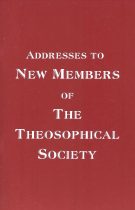H.P. Blavatsky the Light-Bringer – The Blavatsky Lecture 1970
By Geoffrey A. Barborka.
67 Pages | Blavatsky Lecture 1970 | Softcover | The Theosophical Publishing House, London. | No ISBN.
This Lecture commemorates the coming to the Western world of one who was the representative of a great Brotherhood – a Brotherhood which is known by many names. One of its epiphets, especially in connection with its origin, is a symbolic one; the Sons of Ad or Sons of Fire-Mist. Little has been written about these Sons. However, the meaning associated with the term is clear enough; for it links up with the name given to those Divine Beings who came to the assistance of humanity during one of its most critical periods. These are the Agnishvatta Pitris, the awakeners of the fire – which signifies the Mind-principle.
Geoffrey A. Barborka (1897 – 1982) was brought up at Point Loma, California. He had a classical education to which were added modern languages / German, French and Spanish+ and these were later supplemented by a study of Hebrew and Sanskrit. He is the author of a number of books, including The Divine Plan, H.P. Blavatsky, Tibet and Tulku and The Pearl of the Orient.
Addresses to new Members of the Theosophical Society
By an anonymous author with Adresses of several renown Theosophists.
46 Pages | Second edition 2010 | Softcover | The Theosophical Publishing House, Adyar | ISBN: unknown.
With Adresses of: Henry Steel Olcott (1832 – 1907), Annie Besant (1847 – 1933), Charles W. Leadbeater (1854 – 1934), George S. Arundale (1878 – 1945), C. Jinarājadāsa (1875 – 1953), N. Sri Ram (1889 – 1973) and Radha Burnier (1923 – 2013).
From the Address of C. Jinarājadāsa:
” My Brother, I address you as a brother and not as a friend, because our whole basis of the work of our Society is based upon the attempt to realize and practise the significance of the great Law of Brotherhood. When you signed up your application to join, you read what are the Three Objects of the Society; but of these the first and foremost is that of Universal Brotherhood […] ” (p. 27).
 Bezig met bijwerken…
Bezig met bijwerken…
